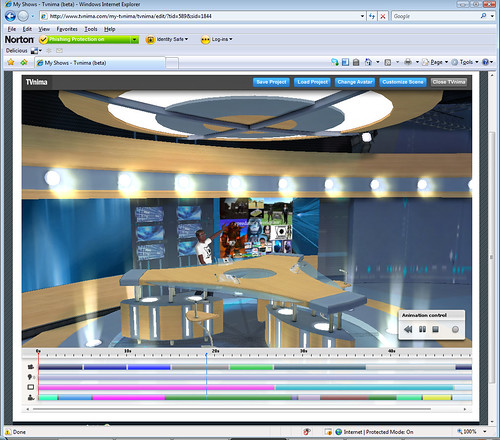I was invited onto the 101st Dogear Nation show this week. The premise is simple, we discuss what is going on out on the web, in particular in virtual worlds and game related areas through the medium of the shared URL. i.e. if you take things on delicious with the tag dogear-nation then they form the selection for the running order of the show.
It is always a blast doing this show and this week was no exception.
Check it out, it will be up on itunes very soon too.
Michael Rowe had also done this advert video for dogear nation this week 🙂
Six Degrees is just a game? Proof of serendipity?
This week the BBC aired a programme on the science of Network Analysis. Since the programme I have talked to lots of people and we have all said the same thing. Yes we knew all about the Six Degrees of Kevin Bacon game. We all live and work in social media (a self selecting bunch of people I talk to of course), so we all understand the power of the connected hub and the ability to link people and ideas and spread the word. We all knew the obvious statements that disease spreads through contact hubs where people have more direct contact with others. We all knew that travel broadens the mind and also the dispersal of families and companies at a global level means the world is smaller.
Its all obvious. That does not mean that it is wrong of course.
The programme sought to show the science and maths involved in the description of the various types of network theory. It also did an experiment involving random people in far flung part of the world having to find a people to help get a package to someone they did not know. i.e. pass it on and see how many steps it really took.
That worked very well too.
The piece of the puzzle that is the most thought provoking is the places these clumped networks of relationships, hubs of influence and transmitters exists. Social Networks, The Web, Flu spreading are the classic obvious ones. However in studying this scientists have found the patterns and principles apply at all sorts of meta levels.
One that I thought they might have explicitly pointed out, but may have just been subtle and clever scripting was the fact that the hsitory of the network theory development was itself a network of hubs and connectors. Someone happened to see an article by someone else etc.
The striking one was that scientists mapped all diseases and their relationships to one another, each has a relationship to another, and some common hubs act as a link between many disparate ilnesses.
Just consider that, every illness we can suffer is just six degrees of separation or less from another via their structure and our genes.
If we look at networks of networks the same patterns will apply. The patterns continue in a repeating fractal nature at any level you care to consider, from brain cells to the eco system, financial systems to planetary systems.
Why is this relevant?
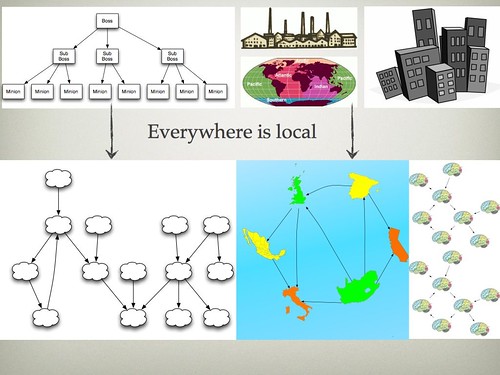
We have through various pieces of technology, from email and the telephone to virtual worlds provided a way to make these connections even faster to use the network effect to transmit ideas to one another. It surely makes sense to be aware of the nature of the structure of networks and hubs that helps adoption of an idea, a technology or a movement.
In trying to help people come to terms with a change you have to deal with the hubs, or reduce your path to the hubs. Convincing people on the periphery of a network has to be done, but the aim is to get to the fast connector, the fast influencer.
It would seem the fast influencer and meta network that many people look to is money. The conversations on technology adoption and its usage tends to be based on objections or otherwise of ROI. However, money is a network in its own right. There are hubs, people with more access to more money that need to be influenced. Money though is not the only network here. As we often say the virtual world and social media is not about the technology it is about people. People themselves are collections of networks, from those they belong to socially, to the collection of neurons that form the brain.
It struck me that the best way to get people to adopt something is not to appeal to just one of their networks. instead to appeal to the network of networks. Just as each disease is shown to be part of its own network of diseases and the cure for one major one might be found by focussing on the nearest apparently unrelated disease on the surface, then adoption curves and getting people to where we think they need to be may be best done via another route than their major network.
I then realized that in some ways I had been explaining this and doing this all along. I often help people who want to know how you convinces crowds of people to follow an idea. The key is to make is personal to each individual. To now dive straight at their primary concern (in business this is money/ROI etc). Instead you appeal to another part of their own network, rather than the network they are part of.
Finding a long lost friend of relative, discovering someone with the same passion for the same hobby, being inspired by an idea, being able to show off, even taking a moment to think of others. All these when applied to the person you are trying to help and convince will work so much better than the £ or $ signs in most cases. Once they have experienced even in the smallest amount a change to their internal biological personal network then they will be open to consider the influence they may have on the networks they are in.
Another example was clearly how the use of Second Life at Wimbledon, via IBM made people consider the potential options of virtual worlds. To me the link made sense, the network and flow was clear. However looking back it is even more obvious in the context of peoples internal influence networks. Wimbledon is an emotive hub. Sport, whilst a business to some is an emotive experience, seldom about the prize money or company share price, but about competition. Attaching such an emotive hub to the personal experiences that we have in virtual worlds made sense. The second hub, that of a solid Blue Chip IT business clearly also appealed to a different network of business. Hence Second Life, Wimbledon and IBM became three super hubs joining multiple networks of people, ideas, emotions and motivators.
I often point out how we have to rely on serendipity. I think now that serendipity really is the collision of multiple types of network at a point in time. Seemingly unrelated things occur and form a pattern we cannot quite discern, but we feel that something is right.
The trick is to feel these networks at all their various levels, not just social and try and weave them and make them collide in a positive way.
So next time you are focussed on one goal, one target, one idea just for a second considered the multitude of networks that that may for part of. Look at those may just get you to that goal quicker, and open up a whole new set of others.
To quote Snowcrash (again) “Is it a virus, a drug or a religion…. what’s the difference?”
Apply Serious Games 2009 – Any questions for Thursday?
Its time again to hit the conference scene. This time heading for London and the SCI venue in Belgrave Square.
Apply Serious Games is in its 4th year, and the metarati are gathering once more.
This time I get to host a session (but I will of course chip in to, just try and stop me).
The session is:
Which Platform is Right for Supporting Industry Needs to 2012? What Are the Technology Trends Over the Next 3 Years, Shaping the de facto 3D Web?
The line up has been in a state of flux, but thats all fine as we are talking the future, keep an eye on the schedule 🙂
We will do a few intro’s and explain we sit and then take any questions or conversation wherever it needs to go.
Questions:
Is three years enough to get the right platforms in place? After all we have had 20 years at least, what has changed, what can we expect?
Do you consider mirror worlds as a valid reason to implement virtual worlds, or should it be considered as a different platform altogether to avoid confusion?
Will industry verticals drive adoption and value or cross vertical approaches?
Can providers of platforms compete with open source movements and tightening of IT budgets?
Leading to this vision
As we are talking 2012 what do you think the London 2012 olympics should look like (as an example of what we may have in 2012 in the way of technology)
So if there is anything you want chipped in, twitter me or post here.
See you Thursday.
Dear London 2012 Olympic people – Wakeup to Virtual!
For a while a few of us have been pushing the odd button, making suggestions and plays to various people that London 2012 really should have a rich and ground breaking virtual component. It could, after all, be the cheapest, yet most far reaching impact on the games and the future of sport.
Sport works in 3d, is rich in statistics, has global interest. Virtual worlds and social media fit very nicely into that space. What do we have for 2012 as a strategy? No idea, cant find one.
Still at least 2012 can be shown the way by what the Singapore 2010 youth games are going to do. This article on Virtual Worlds News shows the bids and sums involved (including my old firm, who’d of think it 🙂 ) You can build a lot of virtual world experience using the available tools and $10 million. Look what we did with no funding and crowd sourcing for Wimbledon in Second Life !
My door/email/twitter/avatars are open to be approached, we are all happy to help. The country has the skills, in fact some people are world leaders in the field, we also have a thriving games industry.
A quick study with Unity3d, dropping things.
I have been looking into Unity3d a little more recently. As a programmer since I was 14 (thats a long while ago) I tend to look at languages and toolkits with a sort of skim pattern approach. I look for tiny pieces of flexibility knowing that if they exist then a lot more can be combined with more effort and time to produce the required results.
Unity3d has this flexibility in so many ways, as well as providing a whole host of useful tools to help create things on a grand scale.
I had already explored being able to get image resources from the web from places like Flickr, once that inbound route is possible then the web can be used for all sorts of triggers to an application. However I wanted to explore the physics and character animation potential.
I am not a graphic designer, nor an expert in high end 3d packages but I do know a little of what I need to do. I started to use the excellent Cheetah3d on the Mac as it is low cost, suites my needs and works well with Unity natively.
Whilst at the airport I built a little person, and also rigged it with bones and joints. The only problem I had was having created the individual prims I could not see how to get them to become one mesh. It turns out you have to use “Import Children” in Cheetah3d. However having done that it leaves copies of the children in the heirarchy, which is helpful but confused me as I thought it was not working. Once that was done though we were all systems go.
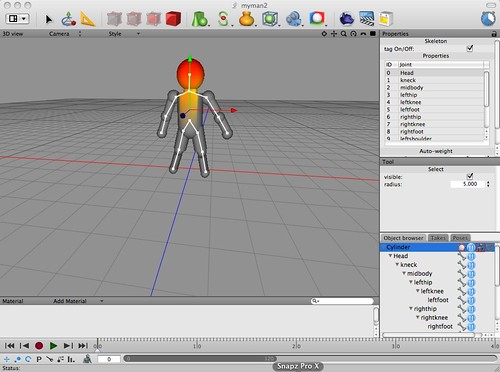
Telling Unity3d about the figure was very simple, a drag and drop in fact.
Once in Unity3d it was easy to create a terrain, select some foliage, have it autiomatically populat the terrain with that foliage. I then used the ragdoll wizard to tell Unity3d about the joints and parts on the Cheetah3d figure.
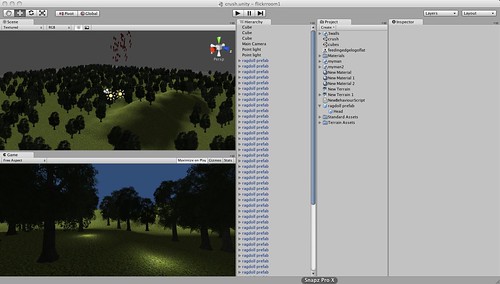
The rest was a few clicks to see what worked.
This example is not “interactive” as such, but just a little example for my own benefit, but I liked the result so I thought I would share it 🙂
****Update I just added little bounce button to throw the things back up in the air again (once they have landed). This is doing a publish of a message to a set of listeners. once again a nice implementation. Of course all the ragdoll physics may make it a little clunky for now real reason, but optimization is another subject:)
You can launch the example here it should do all the plugin checking for you I hope
Washington 3DTLC, twitter, education and progress
I just got back from my trip to Washington to the very excellent 3DTLC conference. This was certainly one of the most productive, interesting and stimulating conferences we have had over the last 3 years. Primarily it was because it was not a conference to convince people of the value of virtual worlds, but to look at ways to move everything forward from that point. The focus being Training, Learning and Education took some of the more traditional focus of “hey how do we turn a fast buck from this” (a.k.a ROI) from the discussions and hit us all with mix of case studies of things done both in enterprise and academia with some future thinking and discussion.

The entire conference was also heavily powered by the twitter back channel #3dtlc was getting a lot of traffic. This should be no suprise from virtual world experts used to attending virtual events, but maintaining an engaged buzz through ongoing discussion. (Apologies to all those not embroiled in this world who happened to experience this all via any facebook flood feeds). So whilst we had no avatars textured or untextured (as above) we certainly all had a virtual presence. The conference was not being streamed to the web as audio or video, but as a considerably set of 140 character conversations crowdsourced and minuting the proceedings.
The location was Gaulledet University, a 99 acre site about 2 miles from Capitol Hill. A very grand campus, though contrasted outside by a slightly different area that many taxi’s seemed unwilling to come to.

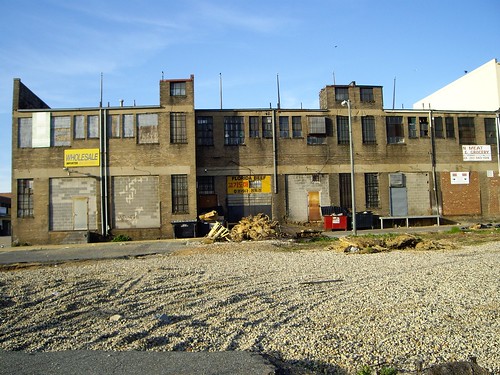
However that did not detract from the content.
Tony O’Driscoll had done a great job of getting the agenda together and inviting people. It was Tony’s request that had persuaded me to spend some of Feeding Edge’s travel budget to get over to Washington.
Analyze, Leverage, Teach, Learn, Design, Explore, Improve, Connect, Extend, Convince where the topic subjects for each panel or interview.
The first panel Analyze had a set of positioning statements about where were are as an industry. Kicked off by Erica Driver from ThinkBalm. The general consensus was that we were still at the early stages. Steve Prentice of Gartner re-iterated the important fact that this is all about people, unlike many other technology adoption curves, and that there was more than one adoption curve interacting here. Several other themes emerged that may or may not be considered a distraction.
1. What do we call this all – Everyone has a name for this, metaverse, immersive, 3.0 etc. Though as Erica pointed out we started with e-commerce, then moved to e-business now no one really talks about it as a thing anymore it is just part of general business. The same will happen to the thread so this immersive revolution.
2. The G word. There was a polarization into whether or not anything or anyone should ever use the word GAME. This again highlighted the point above on clarification of what “this” is. In some cases using games and games technology makes sense, in others it is not going to get anywhere in the adoption curve for some of the purse string holders. There is no one answer. Though I must say that when I started in the IT industry 20 years ago it was frowned upon, even as a software engineer to have the word Game on your CV. Now it is very prominent on mine an part and parcel of any discussions and work I do. That does not mean every solution to every problem has to be a game based one though.
The Leverage section was an interview with Joe Little from BP. Joe has managed to carve out a good official and respected position with BP providing a whole set of examples of how they have used both virtual world and visualization technology in a host of applications. An interesting one was around building a team of students up as a team before going on a physically demanding exploration to the antarctic. The virtual world elements let people get to know one another first, something a few of us have done so we know its not an isolated case. Joe’s examples were not all one platform or one example but a spread, and for any doubters in the audience (though they were an experience bunch) it provided a safe grounding.
Teach, saw a fantastic set of panelists who had between them enormous experience as educators and virtual world experts in the field doing, trying, observing adjusting and reporting what they do. Pedagogy started to be mentioned alot. Challenging the fact that education has up to know been restrictive in its approach, and that simply replicating boring broadcast lectures in a virtual world will not work any better. Students asleep at a real desk will still be asleep at a virtual desk. The famous Sarah Robbins a.k.a Intellagirl told a fantastic story around letting students get to safely understand social exclusion and discrimination through Second Life. In here example she explained how she set her students a task to go to a Second Life night club, but they all had to be as outsized round spherical avatars (Kool-aid men). Their individual experiences did not really include much societal diversity. They re-appeared form the club 5 minutes after going. Intellagirl was not sure why they were so quick, but it turned out that they all turned up, and were very quickly politely ejected for not fitting the social norm of the venue. Each of the students was able to explain their feelings of exclusion and appreciation of the potential problems that attitudes can have on people. As she pointed out it would be very hard to compare that educational experience with any other way of doing it quite so safely. Hence the ongoing conversational them about “justify why a virtual world” is often used as a weapon to stop change usually by trying to make a comparison to things we can already do. This being an example of something we cant do usually, but had clear benefit in discovering this way of working.
Design as a panel showed some interesting ways of getting things done in virtual worlds. I missed some of the panel but did see Boris Kizelshteyn of Popcha! get a admiring round of applause for diving into a live Second Life demo of their presentation toolset and also bootlegging the conference by using video streaming from his webcam back into Second Life. That rounded the day off nicely from the main conference.
The evening for me was mostly spent at a ThinkBalm event with lots of the drinks bought by Erica and Sam Driver. The conversation was varied and very interesting. We talked lots about Augmenting Reality in various forms.
 Day 2 started with the panel I was speaking on. Explore. With America clearly in a mood for change and for the future the main focus of the session was explaining the Virtual Worlds Roadmap. (An excuse to use a photo of the capitol building) Sibley had managed to get to the venue after some major knee surgery and was sporting not only his trademark hat, but a very impressive leg brace. Koreen was our MC, and set us off on our way.
Day 2 started with the panel I was speaking on. Explore. With America clearly in a mood for change and for the future the main focus of the session was explaining the Virtual Worlds Roadmap. (An excuse to use a photo of the capitol building) Sibley had managed to get to the venue after some major knee surgery and was sporting not only his trademark hat, but a very impressive leg brace. Koreen was our MC, and set us off on our way.
Sibley explained the premise of the roadmap, that many of the things we are doing today with virtual worlds, we could have done a long time ago. (For me this resonates with the comments from the first session where there are multiple adoption curves and people are a major factor in all this). The roadmap, as Sibley pointed out, is there to break things into industry verticals, to evaluate what we can and can’t do to meet those needs and then work out how to get the gaps plugged.
Next up on intro’s was me, I first of all made it clear that I was still epredator, but I was not still with IBM, just in case anyone had not heard the news. I made three points about the future.
1. I explained that we were washing away cave paintings, that up until now everything we have done has been broadcast media, that telling people where the hunting grounds were, where the dangers were etc was replicated in how we do books, tv, film etc. Its also how we do education in a classroom (Linking back to the teach panel). It was a 30 second version of the keynote from ACE in ireland.
2. There is no one platform to solve all the problems, nor is there likely to be. It is not a case of sticking to or picking one deployment platform and then standing back. I mentioned the difference in need in something like The Coaches Centre that doing a classroom education of some standard texts requires very different technology to the fluid dynamics to coach swimming, or the physics in tennis, or the physiological models to teach doctors. Its not one simulation, not one virtual world, not one platform as much as its not one industry vertical.
3. Assuming the above is the case, things will need to interoperate in ways that suit us as people. We need ways to describe and combine education and training plans that span all types of media and place. This is not simply a case of can x import model from y. It is more about the meta description of how we combine the appropriate levels of simulation, interaction and content from the right places. I added that we need to think how we not only augment the physical world with the virtual but how we augment the virtual worlds with other elements of the virtual.
John then talked about his vision of high end simulations, where and why Intel are interested and also as a co-founder with Sibley, reiterated the depth of the work in the roadmap and that it was for everyone to join in and sort out.
Eiliff then also introduced the deeper elements needed for people to be able to learn by exploration, once again re-iterating the elements of learning dont just come from re-replicating the classroom and that we can take this further than ever now.
The rest of the panel time was in various discussions that built on and around these points. I put it to the panel and audience that I think that the platform and tech discussions will get blown away when people from the games industry (with their budgets and huge infrastructures) figure out that benefits in business bring a whole new dimension and scale to this. Sibley pointed out they probably would not as they were comfortable where they were. I agreed, but suggested that a drop in gaming revenue, or some industry pressures might make them look elsewhere, or the proliferation of easy to get middleware and game creation tools such as Unity3d might make lots of game related startups adjust their focus.
At some point I found myself singing the praises of IBM’s Sametime 3D and in particular how in the adoption of some of this way of working just putting it into the normal workflow of everyday life just makes the challenges and barriers melt away. The full on product development cycle merging enterprise instant messaging so that it can, as needed, allowing anyone to spark up an opensim room so say “let me show you” action some things and then close and move on needs someone like IBM to deliver it.
Next up was Improve. A panel led by Erica Driver. Once again this was real projects getting to be explained. From J&J recruiting, to SAP’s approach to total integration with physical assets (Shaspa got a good few mentions here), to Robin Williams from Sun explaining the multitude of good work in both SL and Wonderland (that we are all praying does not get killed by the Oracle monolith) and finally ending with Kevyn Renner from Chevron who won the award for the sparkiest most dynamic delivery of the whole show. Chevron using all sorts of 3d for years, but increasingly using collaborative immersive 3d real world training and safety issues. Twitter was particularly alight with surprise as he got off stage and wandered around with a glass in his hand to demonstrate a “thing” whilst having a pop at the Australians (being from New Zealand). It was a great pitch and the panel also dealt with lots of questions. Robin was particularly on form with very similar response to the typical questions that saw me nodding profusely.
Connect was the next panel up. Sam Driver was leading, first up was Robert Broomfield from Metanomics fame. He explained much of how he fell into being the chat show star in Second Life, how the show grew and how now with Treet.tv it is growing further and being injected into more environments in more ways. I like this point a lot, as it fitted with my panel’s conversations around not just having one environment.
Next up Joanne Martin, President of the IBM Academy of Technology. Joanne explained the AoT and the fact she is in one of the few elected positions in the company. The Academy is IBM’s technically focused leading thinkers. The case study was one that Joanne admitted when she started she knew nothing about virtual worlds (I must have missed one in my conversions 🙂 ) but that when the great and good from IBM had their massive yearly conference cancelled almost at the last minute due to money concerns they had to come up with something quick. The AoT meeting was the first foray with the original behind the firewall solution with Linden Lab and Second Life. Joanne pointed out they used lots of other online connections, webcasts, wiki’s etc, but that the Virtual world had a massive benefit of serendipitous conversations and mingling with fellow attendees. This whole thing is the case study written up by IBM and LL recently. I had always known the AoT would be key in adoption.
The recipe
1.Take a bunch of talented, but sometimes stuck in their ways old hands with a hint of the mad inventor in them.
2. Take away a long cherished physical gathering due to budget.
3. Put some new ways of working in front of them all.
4. If it works completely, the key influencers will say why did we not do this before
5. If it works a little bit, the key influencers will say, why could we not do this better?
6. If it breaks, they will say heck we are IBM surely we can make this work, get out of the way let me try.
End result, adoption, products, industry.
Of course for them even to get to that point I know full well it needed demand generation and evangelizing in the lead up, otherwise things like a behind the firewall virtual world would not have even got a look in. To think some people told me there was no business value in virtual worlds, and now the president of the AoT was on stage saying precisely the opposite.
Claire from Cisco told a similar tale, slightly different technologies used sometimes (they do own webex). Of course again this was interesting that my fellow opposite (though slightly higher) number Christian Renaud had shepherded Cisco to a similar point.
Jaque divided the audience with a delivery about a volunteer virtual police and security force initially in Activeworlds but spanning into other places too. The questions raised of who watches the watchmen? Whether it is ok to need a police force or if we are all self governing certainly caused a ripple on twitter. All the things Jaque said I think I have experienced, and in some cases had to do. Talk down a potential griefer etc. Yet at the same time, a self appointed set of police seemed odd. A subject that will certainly keep on getting attention.
The penultimate panel was Extend. Tony was the moderator. There was quite a mix on the panel from the extremely touching and emotive work from the US Holocaust Museum, to the outreach to industry analysts on products from Sun, to KPMG’s recruiting fairs initially in Second Life then more lately in Unisfair and finally Tim from Pearson talking about his customer work with ECS as a partner for The Coaches Centre.

The Coaches Centre is something that I am very close too especially with my background with sports and virtual worlds with Wimbledon, so it was interesting hearing a partner/provider talk about it when ideally it should have been TCC themselves. The basics of TCC is to improve the quality and experience of sports coaches at all levels using new and immersive technology. Currently the pilot with Pearson/ECS as content providers is running in Canada, but it is just the first step in something much grander that I can see will blossom from this, and as I mentioned in my panel an extend across many platforms and could aggregate and augment all sorts of elements of social and simulation technology.
The final panel was Convince. A body of fellow metaverse evangelists sharing their insights into how to get buy in where needed. Karen Keeter from IBM spoke and as a fellow colleague it was very familiar 🙂 Karen also showed Sametime 3d. John from Intel, Emily from Cisco and Brian form Etape also spoke.
John Hengeveld was also on my panel. His main tips were that each project has an impact so make sure you capture it (positive or negative)
Emily was indicating her sales force just would not for anything that was not bullet proof and obvious to use.
Brian rounded up the discussion by saying how he came at this from customer need, not out of a passion for the ideas. This was a great matter of fact pitch. They needed something, we tried virtual worlds, and wow we got so much more than we bargained for.
The conference then wrapped up, with a big round of applause for the organization and content.
A few of us twitterers then retired to an Irish Pub for Guiness and chat, but thats another post and this was way too long.
My own TV show?
Aside from the comparisons in some of my attitudes to Jeremy Clarkson, or my passion for sharing information with people and making then feel involved I have only really ever done on stage presentations, unscripted, face to face meetings, the odd podcast, TV appearance and a stack of virtual world gatherings in Second Life.
I recently came across something Dassualt Systemes have put together that enables us to edit up virtual TV shows mixing simple content and interesting camera movements. Its called http://www.tvnima.com/
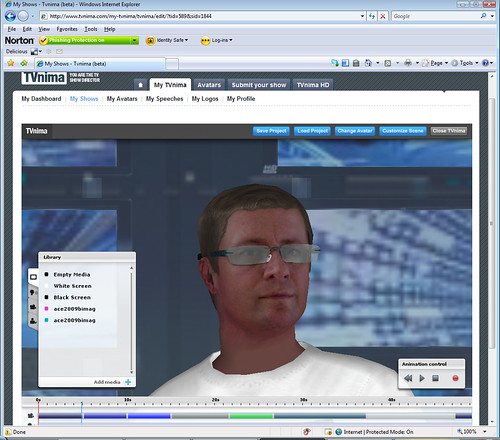
It also lets you do the 2 photo facial avatar creation which for a first attempt on my part seemed to work quite well I think. (Not really done much with my hair).
You have to currently do this all on IE due to the plugin wanting to be the uploader for content from your machine, and they have not put in an easy to find player (to let you just see my first attempts), and Fraps cant capture it on my machine as the colour palette gets messup. However, apart from that it shows great promise as something very simple to use.
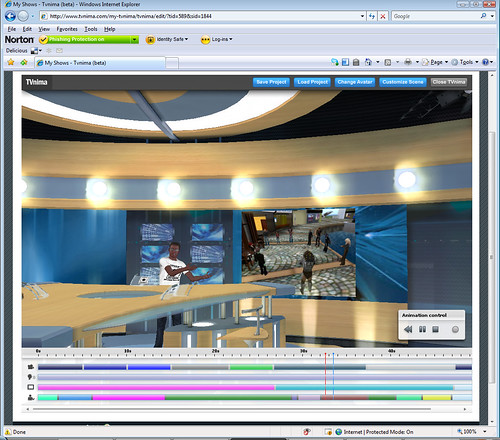
I basically laid down 1 minute timeline, 2 shots form a keynote pitch, picked some camera pans, closeups the odd gesture and then recorded a voice over to go with it. If I can get the content out as easy as I put it in I will do my most recent pitch all in this as an advert for what I do here at Feeding Edge.
The various panning camera movements and simplicity to string them together was very impressive. No real fighting the interface or trying to sort out a dolly for a camera to move across.
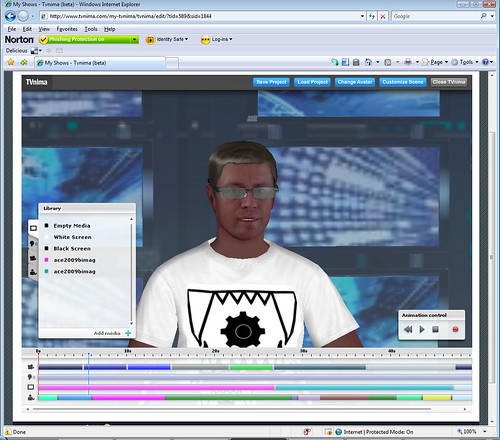
This is not a live performance tool (yet) and is a single user, but it does show some of the simplicity of interface and user functions that lets us just get on with the content.
Of course having got a a real rush from all the presenting I do and the enthusing I do, if I now get a taste for a TV studio….. Well I am open to offers, failing that I will just create my own show.
Latest merger news : Work and play combine
Last night I had the pleasure of speaking at a Nokia connecting worlds event in Second Life. The subject for the panel of us invited to talk was that of human and non human avatars. In particular we represented people with avatars in SL or multiple looks in SL that were not regular real world mirrors.
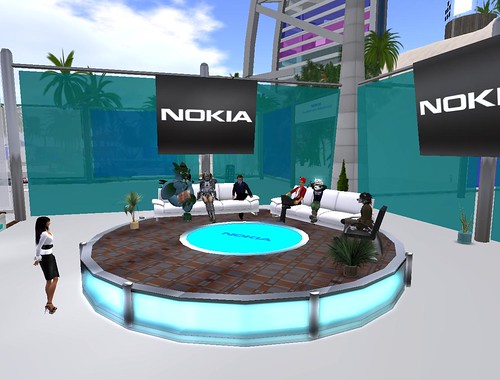 It was a very interesting set of perspectives that we all brought to the event I think. The discussion of identity and the prejudice and also the power of using particular ways of interacting in virtual environments is a rich subject. It is also full of personal experience and though for each of us.
It was a very interesting set of perspectives that we all brought to the event I think. The discussion of identity and the prejudice and also the power of using particular ways of interacting in virtual environments is a rich subject. It is also full of personal experience and though for each of us.
Faced with an avatar based experience everyone who enters has to choose something, even if the choice is to do nothing, to represent them. However as they engage and act the avatar starts to not just be a visual but a repesentative of attitude and action.
The panel was formed of Blue Linden, Myself, Digistar Brouwer of Nokia, Hiro Pendragon, Selkit Diller and Flea Bussy, moderated by Hydra Shaftoe.
Also for me the conversation and answering the questions ranged from my experience at a large corporation having represented both myself and their interests as epredator, flowed into how I show the fact I am clearly a science fiction fan with my AV and also how I try and act with the same strength and honour blended with the ethos of another character.
Clearly all that in conversation blends business and play in many complicated ways. The need for personal brand, for ego and for championing a business cause yet all being described to a group of people world wide when for me it was 8pm and I was at home having just put the predlets to bed.
It was captured by the newly forming Treet.tv (link to follow once the archive is up)
So clearly work and play (which can be the same thing if you enjoy the work) have already merged. Sharing personal experience that some people may use for commercial advantages, or for personal enhancement crosses the boundaries.
As I often say all this is about people. Thats the bottom line. People connecting and getting done what they need to do, direct to one another with reduced overheads.
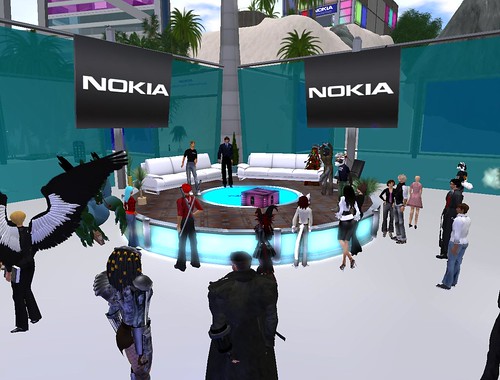 As is also customary at any online gathering there is a post event mingle, this shows the great leveler that virtual worlds are as the social construct of audience, stage, panelists just stops and intermingles as it does at any good conference event.
As is also customary at any online gathering there is a post event mingle, this shows the great leveler that virtual worlds are as the social construct of audience, stage, panelists just stops and intermingles as it does at any good conference event.
We ended up discussing WoW, Female/Male potential prejudices and sandwiches.
There were a few eightbars (both current and former IBMers) who came along too so it was good to see everyone again.
Thanks all for the discussion and look out for the video when its posted to hear everyones point of view.
The video is now ready
Or a direct link is here (Thank Digistar 🙂 )
Heading for Washington and 3DTLC
Well its official. Feeding Edge is on the road and heading for Washington in a couple of weeks for the 3DTLC. I have the honour of being on a panel with some very cool people. This is a little change from when I was not sure of my travel budget, but this is well worth the investment.
EXPLORE: The Enterprise Applications Emerging Over The Next
Two Years
The Virtual World Roadmap team will EXPLORE the enterprise
applications they see emerging over the next two years and the
technology features that will enable them. Topics
to be discussed include: key applications seen emerging in
Education/e-Learning/Training; key technological functionality that
must emerge for learning; key technological functionality that must
emerge for Connecting; and other applications should we take note of
(Visualization, Design, Customer Facing).
Koreen Olbrish, CEO, Tandem Learning (interviewer)
Eilif Trondsen, Research and
Program Director, Virtual Worlds @ Work
John Hengeveld, Senior Business
Strategist, Intel Corporation
Sibley Verbeck, Chief
Executive Officer, Electric Sheep Company
Ian Hughes, Managing
Director, Feeding Edge Ltd
So I hope to catch up with a good few people and see where we are going with all this over the next few years too.
Excited about Metaplace
Today I dived back into Metaplace and I have to say I am now very excited by its potential. I realized I had a stack of invites still so I twittered about it as one does.
So why now? Well I am busy looking at all sorts of platforms and anything that lets people just get on and do things, whilst sharing with others works for me.
Some key points.
1. My avatar can have green hair (Something PS3 home and Xbox Live still don’t do for some reason). i.e. flexible to what I personally want to do. It sounds minor but it really is important.
2. The car there as an isometric 3d object that can be rotated through 4 angles has come from Google Warehouse.
3. The image of epredator’s workplace is from my Keynote as the ACE conference. Its imported from my machine (as a jpg but its powerpoint/keynote in world)
4. You cant see the alien creature I added from the metaplace store. It is a 3d alien, but I clicked the properties to add movement code to it, and selected it should avoid me as a player. So it ran away. Scripts and code…. tick.
5. I was able to create my own space, in this case a feeding edge room. (group space and branding now playing a part)
So with imports, code to make things happen, all running in flash, backed up by a linked social network its letting people just get on and build. Always a design feature but its working really well.

